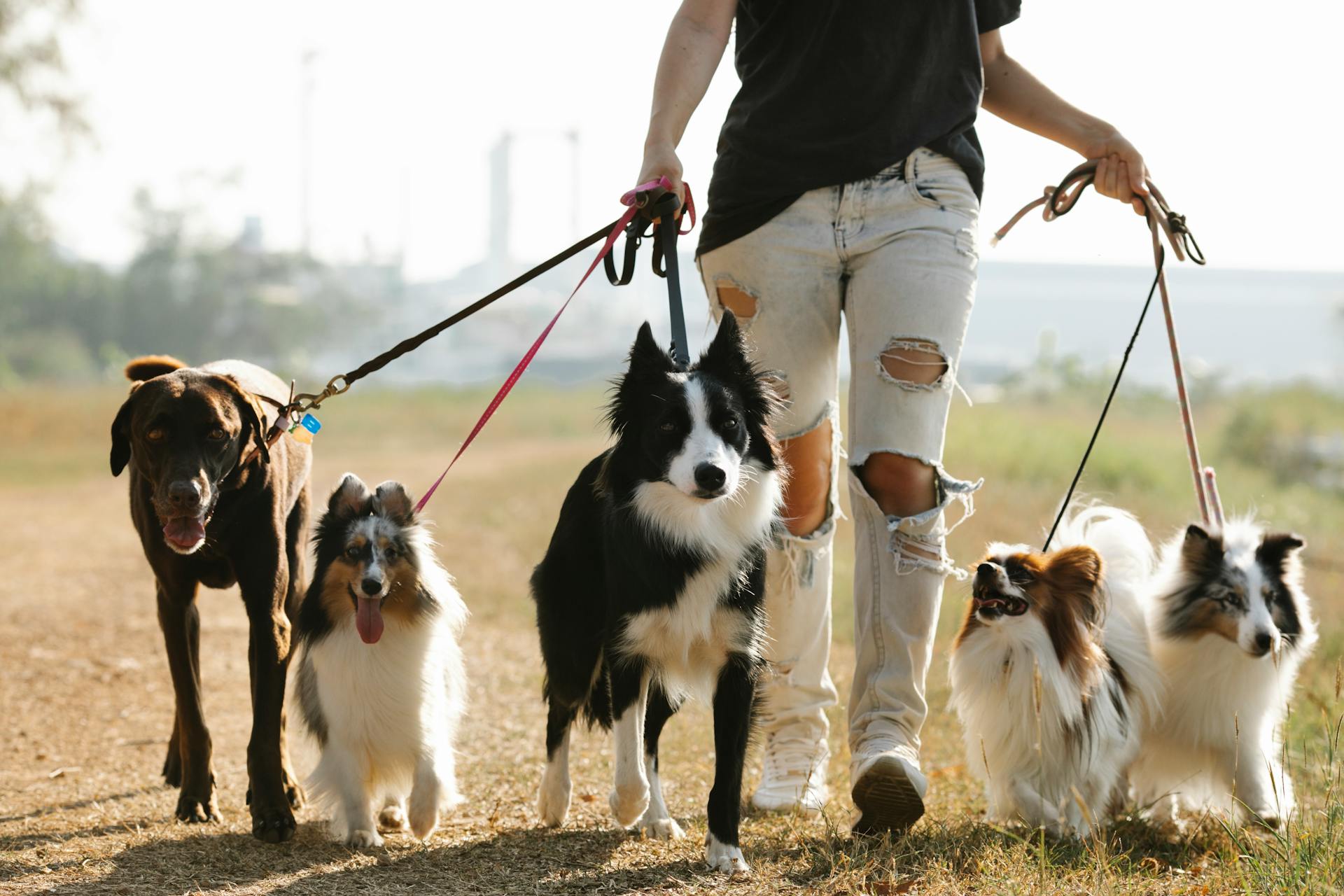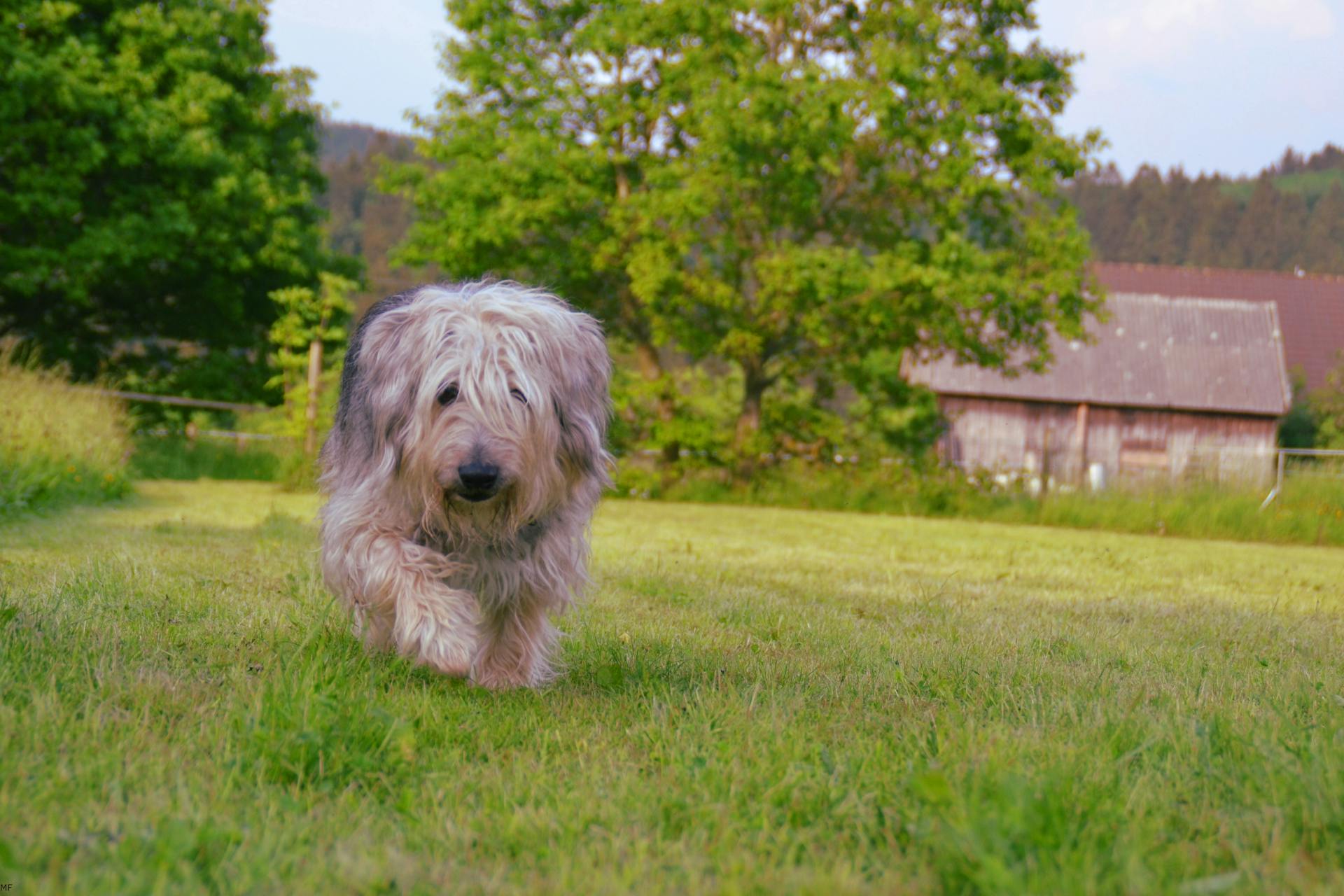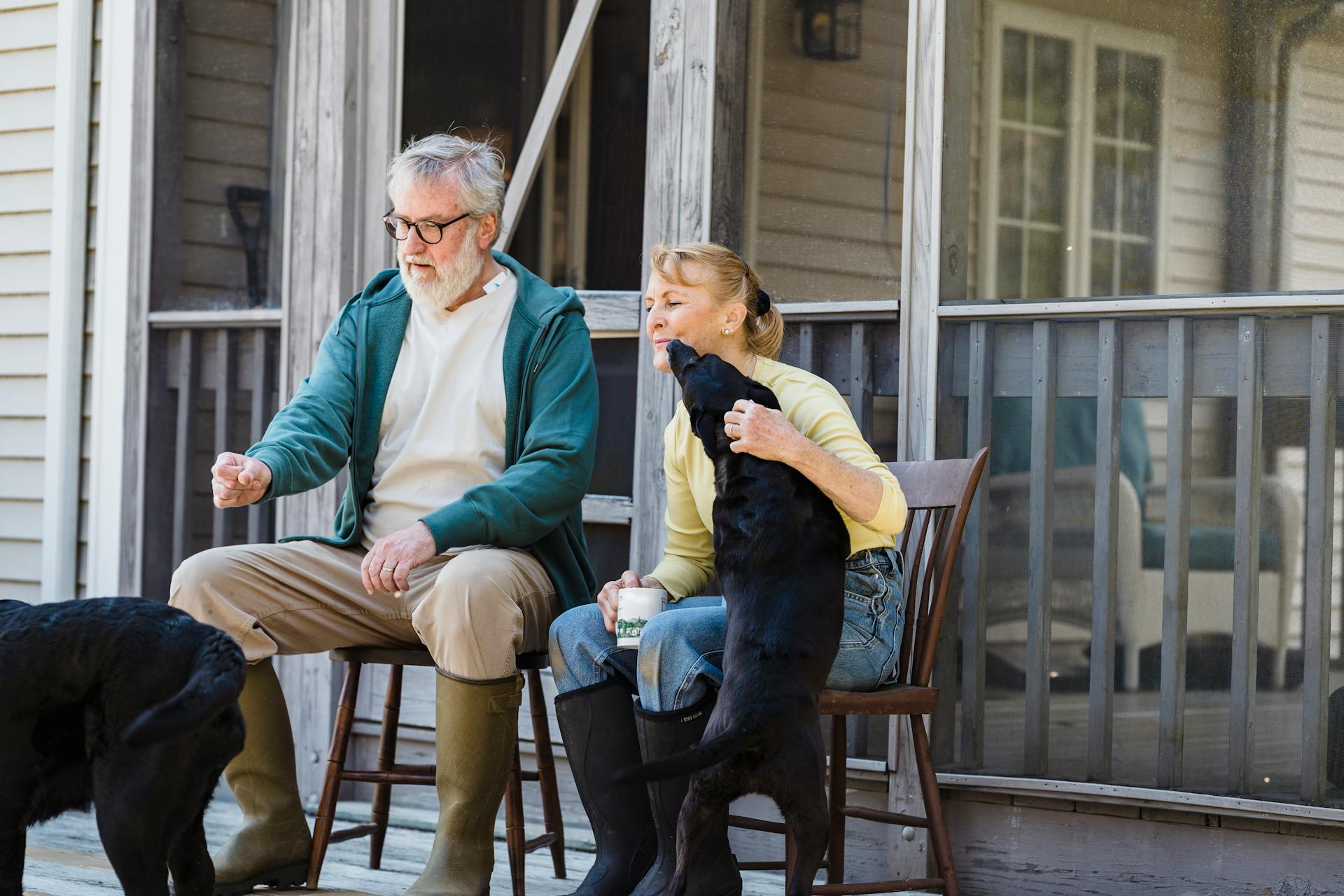
If you're considering training a service dog for mobility and independence, there are several programs to choose from. Some programs specialize in training dogs for specific tasks, such as opening doors or picking up items.
One such program is the Canine Companions for Independence (CCI) program, which provides dogs that can open doors, pick up items, and perform other tasks to assist individuals with mobility issues. CCI's dogs are trained to be highly skilled and obedient.
According to the CCI program, their dogs can be trained to perform up to 40 different tasks, including opening doors, picking up items, and turning on lights. This level of training can greatly increase an individual's independence.
A fresh viewpoint: Canine Companions for Independence
Service Dog Training Basics
Training a service dog requires patience and dedication, with a minimum of 120 hours of training over six months, plus 30 hours of training in public. This extensive training is necessary to ensure your dog becomes a reliable and skilled service animal.
Socialization is a crucial aspect of service dog training, and it's essential to start socializing your puppy between 3-20 weeks of age. This involves handling your puppy frequently by different people, acclimating them to various sounds, and teaching them to be alone without developing separation anxiety.
To prevent messes indoors and teach your dog to "go" on command, potty-training is a must. Crate training can help with this, as it provides a safe and clean space for your dog to relax in.
Leash training is also vital, as it helps your dog understand their limits and stay focused on you. Basic obedience commands like "sit", "heel", and "down" are also essential skills for a service dog to learn.
Here are some basic skills your service dog should learn:
- Down
- Sit
- Come
- Heel
- Stay
These skills will help your service dog learn the positions necessary for their task training and work, as well as focus on their current task despite distractions.
Preparation and Socialization
Socialization is key when training a service dog. You want to expose your pup to a wide range of sights, sounds, smells, people, animals, and other distractions to help them stay focused on the task at hand.
To socialize your pup properly, take them to different locations and expose them to various situations. This will help them become unphased by distractions and learn to focus on what matters.
As for when service dog training begins, it starts in puppyhood. At this stage, they'll learn basic obedience exercises and skills, including crate training, housetraining, and what to play with or chew.
A fresh viewpoint: Dog Training with Distractions
What Are the Requirements?
To be eligible for a service dog, you need to have a permanent disability that significantly limits one or more major life activities.
A service dog must be well-mannered and trained to perform specific tasks that aid someone with a disability.
You'll need to be prepared to answer two questions about your service dog if it's not obvious what service they provide.
A service dog must be brave, large, and intelligent enough to do the job, and must never pose a safety threat to the public.
They must also be able to perform their task 90% of the time or more, no matter the environment.
Check this out: Specific Tasks for Service Dogs
When Does Training Begin?
Service dog training begins in puppyhood, where they learn essential skills like crate training, housetraining, and what to play with or chew.
Puppies start learning basic obedience exercises and skills, such as confidence building, mobility games, desensitization, and scent skills, which lay the foundation for their future training.
These early exercises help puppies develop into well-behaved dogs, setting them up for success in their future roles as service animals.
Here are some of the key skills puppies learn in their early training:
- Crate training
- Housetraining
- Learning what to play with or chew (and what not to)
Socialize Them Properly
Socializing your service dog is a crucial part of their training. It's essential to expose them to a variety of sights, sounds, smells, people, animals, and other distractions.
You want to get your pup accustomed to all sorts of stimuli, so take them to different locations and expose them to different situations. This will help them become unphased by distractions and focus on the task at hand.
To socialize your service dog effectively, consider taking them to various public spaces, such as parks, stores, and restaurants. This will help them get used to new environments and people.
A different take: Financial Help for Service Dogs
Here are some specific things to expose your service dog to:
- Sights: cars, bicycles, people walking, and other animals
- Sounds: loud noises, music, and other distracting sounds
- Smells: different scents, such as food, perfumes, and cleaning products
- People: strangers, friends, and family members
- Animals: other dogs, cats, and other pets
By socializing your service dog properly, you'll be helping them become confident and calm in new situations, which is essential for their success as a service dog.
Prepare for Training Time
Training a service dog requires a significant time commitment. It's essential to have at least six months to devote to the process.
You'll need to spend a minimum of 120 hours training your dog, which can be a challenging but rewarding experience.
Training in public is also crucial, and you should plan to spend at least 30 hours doing so. This will help your dog become comfortable and confident in various environments.
Remember, there's no quick fix or easy solution to training a service dog. It's a process that requires patience, hard work, and a positive attitude.
Training Process
Training a service dog requires a significant time commitment, typically at least 120 hours of training over six months, with at least 30 hours of training in public.
Socialization is a crucial part of training, and it should start early, ideally between 3-20 weeks of age. This involves handling your puppy by several different people, acclimating them to different sounds, and teaching them to be alone to prevent separation anxiety.
To prevent messes indoors, potty-training is essential, and getting a crate can help your dog have a safe place they want to keep clean. By keeping them in the crate and letting them out to relieve themselves, you can teach them to "go" outside on command.
Leash training is also vital, teaching your dog to stay focused on you and not get distracted by things around them. Basic obedience commands like "sit", "heel", and "down" are also important to teach your dog.
Curious to learn more? Check out: Crate Training vs Not
Step 1: Determine
Determining if your dog can be a service dog is a crucial step in the training process. It's essential to consider your dog's age, temperament, attention span, and limitations before starting the training regimen.
Your dog should be over 6 months old and neutered/spayed to minimize distractions while training. This will help you focus on teaching specific tasks for your disability.
A service dog needs to be calm and collected, with a temperament that's not too aggressive or too passive. It should respond calmly to other dogs, but not ignore them entirely.
Your dog's attention span is also crucial. It should be able to focus during teaching sessions and not get distracted by its surroundings, especially in public places.
Consider the limitations your dog may have and how they can affect yours. For example, if you need a dog to help with balance, a larger breed might be more suitable than a smaller one.
Here are some key questions to ask yourself about your dog:
- How old is the dog?
- What’s the dog’s temperament?
- How is the dog’s attention span?
- What limitations does the dog have?
If your dog meets these criteria, it's likely a good candidate for service dog training. If not, you may want to consider getting a trained dog or working with a professional trainer to find a suitable dog.
Step 2: Teach the Basics
Socialization is key to raising a confident and friendly adult dog. Ideally, it should occur between 3-20 weeks of age.
Puppies should be handled often by several different people to get used to new faces and voices. This helps them become comfortable in new situations and around strangers.
Socialization also involves acclimating your puppy to different sounds and environments. You can do this by exposing them to various noises and taking them on outings to new places.
To prevent separation anxiety, it's essential to teach your puppy to be alone. This can be done by gradually increasing the time they spend alone in a quiet room.
Potty-training is another crucial aspect of basic training. Crate training helps with this by giving your puppy a safe place to keep clean.
By keeping your puppy in the crate and letting them out to immediately go relieve themselves, you teach them that "going" outside is good.
Leash training is also vital for your dog to learn their limits. Your dog should learn to be focused on you when appropriate, not on the things around them.
Here are the three essential skills to focus on in basic training:
- Socialization
- Potty-training
- Leash training
Basic obedience commands like "sit", "heel", and "down" are also beneficial to teach your puppy. These commands will help your puppy learn to follow instructions and behave well in public.
Intriguing read: Puppy Raiser for Service Dogs
Mobility Assistance
Training your mobility assistance dog requires specific tasks to help you lead an independent life. These tasks can include pulling your wheelchair, closing or opening doors, bringing you objects, and turning on and off light switches.
Mobility assistance dogs can be trained to assist people with mobility difficulties, such as those who are wheelchair dependent. They can help with everyday tasks and provide support when needed.
Service dogs, including mobility assistance dogs, are trained to perform specific tasks for their recipient's disability. This can include tasks like retrieving dropped items, providing balance, and opening/closing doors.
Some common tasks for mobility assistance dogs include:
- pulling a wheelchair
- opening and closing doors
- bringing objects
- turning on and off light switches
These tasks can help you navigate daily life with greater ease and independence.
Your
You're considering training your own service dog, and that's a great decision. Service dogs can be trained on a variety of tasks, including retrieving dropped items, providing balance, and alerting prior to a seizure.
To start, you'll need to teach your dog basic skills like sitting, staying, and coming when called. These skills are essential for service dogs to learn, and they'll help your dog focus on their tasks.
As you progress in the training process, you'll need to specialize your dog's training based on your specific needs. For example, if you need a hearing service dog, you'll need to teach your dog to respond to ringing phones, doorbells, or fire alarms.
Here are some specific tasks you can train your service dog to do:
- Retrieving dropped items
- Providing balance
- Alerting prior to a seizure
- Diabetic alert
- Mitigating challenges of PTSD by shielding, grounding from anxiety/panic attacks and flashbacks
- Waking someone from nightmares
- Help someone transition from sitting to standing
Remember, service dogs are trained to be invisible in public unless they need to perform a task for their recipient. With patience, practice, and the right training, you can help your dog become a confident and capable service dog.
Training Types and Tasks
Training a service dog requires a lot of time and effort, typically around 120 hours of training over at least six months, with at least 30 hours of training in public.
Training a service dog involves teaching them to perform specific tasks to help mitigate your symptoms. This can include tasks like retrieving dropped items, providing balance, and turning lights on and off.
Service dogs can be trained to perform a variety of tasks, depending on the person's disability and needs. Here are some common tasks service dogs are trained to do:
- Retrieving dropped items
- Retrieving the phone
- Providing balance
- Turning lights on and off
- Opening/closing doors
- Helping a fallen person back to a standing position
- Alerting prior to a seizure
- Diabetic alert
- Mitigating challenges of PTSD by shielding, grounding from anxiety/panic attacks and flashbacks
- Waking someone from nightmares
- Help someone transition from sitting to standing
It's also worth noting that some service dogs, like seizure response dogs, can be trained to physically remove their owners from a situation that could potentially trigger a seizure, or to retrieve medication or get help.
A different take: Service Dogs and Seizures
What Tasks Are Trained to Do?
Training your service dog to perform specific tasks is a crucial step in becoming a service animal. Service dogs can be trained on a variety of tasks, but their specific training will depend on the person's disability and needs.
Task training is a major part of service dog training. Without learning the proper tasks, a dog cannot become a service dog. Service dogs can be trained on tasks such as retrieving dropped items and providing balance.
Here are some common tasks for service dogs:
- Retrieving dropped items
- Retrieving the phone
- Providing balance
- Turning lights on and off
- Opening/closing doors
- Helping a fallen person back to a standing position
- Alerting prior to a seizure
- Diabetic alert
- Mitigating challenges of PTSD by shielding, grounding from anxiety/panic attacks and flashbacks
- Waking someone from nightmares
- Help someone transition from sitting to standing
Some service dogs are trained to perform specialized tasks, such as alerting their owner to changes in blood glucose levels or helping someone with epilepsy during a seizure. These tasks require specific training and can be just as important as more general tasks.
Hearing
Hearing dogs are trained to alert their owners to important sounds, like phone calls or even smoke alarms.
These dogs are a game-changer for people who are deaf or hard of hearing, allowing them to stay connected and safe in their daily lives.
Their training is tailored to the specific needs of their owners, so they can respond to a range of sounds that might be missed by their owners.
For another approach, see: Hearing Dogs for Deaf People
Service Dog Types and Breeds
Not all dogs can be Service Dogs, as they require specific traits and temperament, such as a calm temperament and eagerness to please their owner.
Labrador Retrievers are one of the best breeds for Service Dogs, as they have the necessary traits to excel in this role.
Your dog must be able to focus on its job and ignore distractions, which can be a challenge for dogs with high energy levels or those that react negatively to strangers.
Emotional Support vs. Service Animal
A Service Dog is trained to perform tasks to help its owner with a disability or mental illness. They are allowed in most public areas.
Emotional support dogs, on the other hand, are not trained to do any specific tasks and simply give their owners emotional support. They do not have public access like Service Dogs.
To be considered a Service Animal, protected under ADA law, your dog must be trained to do work or perform tasks for your disability. This requires a lot of work and it's recommended to consult with a professional trainer or canine behaviorist before starting the training process.
Service Dogs are trained to perform specific tasks for your specific symptoms, and the work and tasks will vary from person to person.
If this caught your attention, see: Emotional Support Dogs vs Service Dogs
Types of
Service dogs come in various types to assist individuals with different needs. Some service dogs are trained to assist people with mobility issues, while others are trained to detect medical conditions.
Mobility assistance service dogs are trained to help individuals with physical disabilities. They can be trained to open doors, pick up items, and provide balance support.
Visual assistance service dogs are trained to assist individuals who are blind or have low vision. They can be trained to navigate around obstacles and detect stairs.
Medical alert service dogs are trained to detect changes in their handler's medical condition. They can be trained to detect seizures, low blood sugar, and other conditions.
Hearing assistance service dogs are trained to assist individuals who are deaf or hard of hearing. They can be trained to detect sounds and alert their handler.
Psychiatric service dogs are trained to assist individuals with mental health conditions such as PTSD and anxiety. They can be trained to provide emotional support and comfort.
Worth a look: Autism Service Dogs for Adults
Is Your Breed Ideal?
To determine if your dog is ideal for being a Service Dog, you need to consider its temperament and traits. Your Service Dog must have a calm temperament.
A Service Dog should be eager to please you and help you. It shouldn't react negatively if strangers come by or try to pet it. This means your dog needs to be well-behaved in public.
Your Service Dog must also be able to focus on a job and ignore distractions. This includes behaving well around other dogs. It's essential that your dog is energetic and can keep up with the demands of being a Service Dog.
Some dog breeds are naturally better suited for being Service Dogs. One example is the Labrador Retriever.
Autism
Autism Service Dogs are trained to help children and adults with autism go about their everyday lives and perform daily tasks. They go through lots of training for their jobs and are excellent, courageous dogs.
These dogs are trained to assist individuals with autism in various ways, including helping them navigate social situations and providing emotional support.
Their training is rigorous and tailored to the individual's specific needs, making them a valuable asset for people with autism.
A fresh viewpoint: Are Service Dogs Allowed Everywhere
Advanced
Training a service dog is a significant undertaking that requires patience, time, and practice. It typically takes no less than 120 hours of training in a time span of at least six months, with at least 30 hours of training in public.
You'll need to spend time training your dog to perform specific tasks that will help mitigate your disability. This could be anything from retrieving dropped items to providing balance support. Each service dog's training is tailored to the individual's needs and disability.
Task training is a major part of service dog training, and without it, a dog cannot become a service dog. Service dogs can be trained on a variety of tasks, including:
- Retrieving dropped items
- Retrieving the phone
- Providing balance
- Turning lights on and off
- Opening/closing doors
- Helping a fallen person back to a standing position
- Alerting prior to a seizure
- Diabetic alert
- Mitigating challenges of PTSD by shielding, grounding from anxiety/panic attacks and flashbacks
- Waking someone from nightmares
- Help someone transition from sitting to standing
As you specialize your service dog's training, you'll need to consider their specific job and the tasks they'll need to perform. For example, a hearing service dog will need to be taught to respond to ringing phones, doorbells, or fire alarms.
Discover more: Service Dogs Registration
Training a service dog requires a high level of expertise, which is why Guardian Angels created a college-accredited program to teach apprentices how to become service dog trainers. This program covers advanced topics such as:
- How to train a dog to alert on a certain high or low for diabetes
- Alerting in advance for a seizure
- How to know when to hit an emergency help button if you were incapacitated
- How to wake someone from a night terror
It's essential to remember that training a service dog is a challenging and time-consuming process that requires patience, dedication, and the right training.
Training Options and Costs
Training a service dog requires a significant investment of time, typically at least 120 hours over six months, with an additional 30 hours of training in public.
Training a service dog can be a costly endeavor, with a trained service dog costing anywhere from $15,000 to $50,000.
However, training your own service dog can be a more affordable option, with courses available for around $349-$599.
Can You Train Your Own?
You can train your own Service Dog, but it's essential to consider a few things first.
Yes, it is possible to train your dog to be a Service Dog, as stated in the article.
Explore further: Volunteer to Train Service Dogs
However, training a Service Dog requires a significant amount of time, effort, and expertise.
While it's not impossible to train a Service Dog on your own, it's crucial to have a good understanding of the process and the laws surrounding Service Dogs.
In fact, the article mentions that there are a few things to consider before deciding to train your dog to be a Service Dog.
For another approach, see: How Long Are Service Dogs Trained
What's the Training Cost?
Training a Service Dog can be a costly endeavor, especially if you're not prepared for the expenses. A Service Dog that is already trained can cost anywhere from $15,000 to $50,000.
You'll need to factor in the cost of veterinary care, food, grooming, and other expenses on top of the training cost. A Service Dog still needs to be cared for as much as an ordinary pet.
Fortunately, some training schools offer courses to help you train your own Service Dog, which can be a more budget-friendly option. Our prices at Service Dog Training School are from around $349-$599.
A unique perspective: Service Dogs for Epilepsy Cost
Service Dog Age and Breed
When choosing a Service Dog, age matters. Ideally, a Service Dog should be at least 1-2 years old before beginning training.
A calm temperament is crucial for a Service Dog, and some breeds are naturally more suited to this role. Labrador Retrievers, for instance, are often a good fit.
Your Service Dog must be eager to please you and help you, and should be able to focus on a job and ignore distractions.
Frequently Asked Questions
How to certify a service dog in Texas?
In Texas, there is no government licensing or certification required to certify a service dog, as it is not a law-regulated process. However, service dogs must be trained to perform specific tasks and meet certain criteria, which can be learned about in more detail.
What animals are covered under ADA?
Under the ADA, service animals are primarily dogs, but miniature horses are also covered if they're individually trained to assist individuals with disabilities.
What is the easiest service dog to train?
Breeds like German Shepherds, Border Collies, and Golden Retrievers are often considered easy to train due to their intelligence and trainability. These breeds can make great service dogs with proper training and socialization.
What are the laws on service dogs in Missouri?
In Missouri, individuals with disabilities have the right to be accompanied by a service dog in public places without extra charges. Service dogs, including guide dogs and hearing dogs, are protected under Missouri law, but there may be additional regulations and guidelines to be aware of.
Are service dogs allowed on Amtrak?
Yes, service dogs are permitted in all areas of Amtrak trains. Learn more about traveling with your service dog on Amtrak.
Sources
- https://animalsdeservebetter.org/service-dog-training-programs/
- https://www.newlifek9s.org/post/tips-on-how-to-train-your-own-service-dog
- https://www.medicalservicedogs.org/what-kind-of-training-do-service-dogs-get/
- https://www.servicedogregistration.org/blog/how-to-train-your-own-service-dog/
- https://www.servicedogtrainingschool.org/blog/how-train-your-dog-be-service-dog
Featured Images: pexels.com


